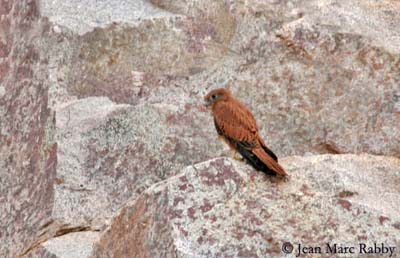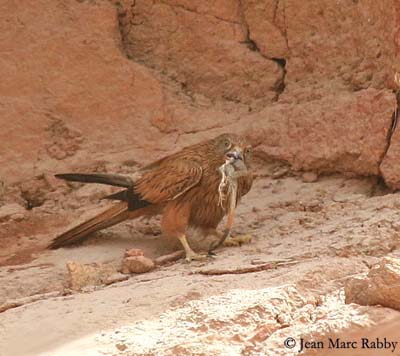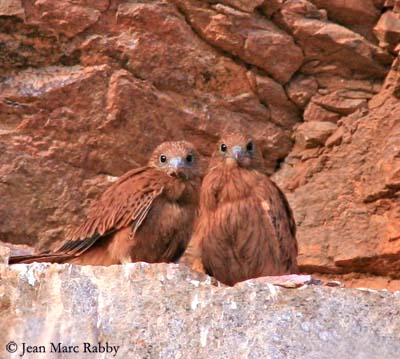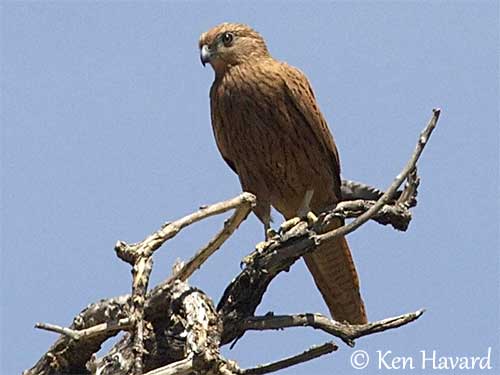
Fox Kestrel
Falco Alopex
Falconiforme Order – Falconidae Family
BIOMETRICS:
Length: 35-39 cm
Wingspan: 75-88 cm
Weight: 250-300 g
DESCRIPTION:
Fox Kestrel is uncommon and poorly known, with limited range. It is a long, slender bird of prey.
Adult has rufous to deep chestnut plumage overall with black streaks, except on the rump.
On the upperparts, nape, wings and back show broad dark streaks. Wings and tail are long. Flight feathers are black. The long tail is rufous with faint and narrow darker bars.
On the underparts, body is rufous streaked black. Throat and undertail coverts are unstreaked. On the underwing, coverts and parts of flight feathers are pale rufous and whitish, whereas the wing tips are black, as the trailing edge. Undertail feathers are similar to uppertail.
The head is rufous finely streaked darker. The hooked bill is black with grey base and yellow cere. Eyes are pale brown, surrounded by yellow eye-ring. The long bare legs and the strong toes are yellow.
Both sexes are similar, with female slightly larger.
Juvenile resembles adult but its plumage is browner. Wing coverts and scapulars are more streaked and tail is more barred than in adults. It has blue-grey facial skin and greenish-yellow legs.
DIET:
Fox Kestrel feeds on large insects (grasshoppers) and termite alates, lizards, and preys such as small birds and mammals, caught from perches.
PROTECTION / THREATS / STATUS:
Fox Kestrel has limited and very localized breeding range, making this species vulnerable.
This bird is usually uncommon and sparsely distributed. It may be locally common in Chad and N Kenya.
However, this species is not threatened at this moment, in spite of the fairly small numbers.
Fr : Crécerelle renard
All : Fuchsfalke
Esp : Cernícalo Zorruno
Ital: Gheppio volpino
Nd: Vosvalk
Russe: Лисья пустельга
Photographers:
Havard Ken - GALERIE
Ses sites : His Bird Pictures on IBC et Flickr gallery 1 et Flickr gallery 2
Jean Marc Rabby
Des Ailes et des Plumes
Text by Nicole Bouglouan
Sources:
HANDBOOK OF THE BIRDS OF THE WORLD Vol 2 by Josep del Hoyo-Andrew Elliot-Jordi Sargatal - Lynx Edicions - ISBN: 8487334156
BIRDS OF THE GAMBIA AND SENEGAL by Clive Barlow and Tim Wacher – Helm Field guides – ISBN: 0713675497
BIRDS OF PREY OF AFRICA AND ITS ISLANDS by Alan and Meg Kemp - Struik Publishers - ISBN: 1770073698
BirdLife International (BirdLife International)
Wikipedia (Wikipedia, The Free Encyclopedia)

VOICE: SOUNDS BY XENO-CANTO
Fox Kestrel is noisy during the breeding season. It utters high-pitched screeching calls “kree-kree-kree”.
HABITAT:
Fox Kestrel frequents semi-desert, rocky hills, cliffs and outcrops along open savannah areas. It can be seen up to 2200 metres of elevation. It is regularly found around isolated rocky hills.

FLIGHT:
Thanks to the long, broad wings and the graduated tail, the Fox Kestrel probably performs buoyant flight and easy hovering, but the latter is rarely observed.
It is able to fly for long periods.
The buoyant flight is performed with slow wing-beats interspersed with glides. It soars easily.
REPRODUCTION:
Breeding season is locally variable, between March and May.
Both mates soar together and call close to the nest-site.
Fox Kestrel nests in natural cavities and rocky ledges on cliff faces. The nest-site is often reused year after year.
This species may nest in small, loose colonies of up to 20-25 pairs.
Female lays 2-3eggs. Incubation is by female alone, but she is probably fed by the male during this period.
No other information recorded.

RANGE:
Fox Kestrel lives in limited range, a narrow sub-Saharan band in the Sahel and NE Africa, from Mali eastwards to Ethiopia and NW Kenya.
It may moves south into moister Guinea savannahs.
Most of populations are sedentary, but some movements occur northwards during the wet season, and southwards during the dry season.
BEHAVIOUR:
Fox Kestrel feeds mainly on large insects, lizards, small mammals and birds as preys.
It hunts from a perch, spending long periods perched on rocks and trees, searching for prey on the ground where it catches them.
It is also attracted to grass and bush fires, taking disturbed grasshoppers and insects on the wings such as termite alates.
